



















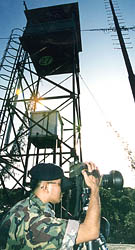 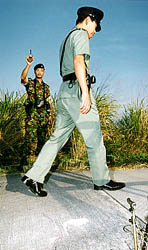 Border District officers use sophisticated equipment (including laser technology) to help foil lls at the HKSAR boundary | THE fourth and final phase of amalgamation of the FPD with the Border District which began in December 1997 was completed in October 1998 with the combining of the Field Patrol Detachment with the Lok Ma Chau Division which is responsible for anti-illegal immigration duties along the boundary near Lok Ma Chan and Mai Po. |
|
"The outcome of the amalgamation has effected improvements to land boundary policing, including more efficient deployment of resources and enhanced command structure along the boundary," said Regional Commander of New Territories North, Ng Wai-kit. With the completion of the amalgamation, Mr Ng pointed out that the Border District's establishment was raised from 659 to 1,205, which improves police coverage along the boundary and further enhances cross boundary anti-illegal immigration liaison. He further noted that the efficiency of anti-illegal immigration duties discharged by police has been maintained after the amalgamation exercise. Police records show that 3,626illegal immigrants (IIs) were apprehended in the Border District in 1997; in the past 10 months, when the amalgamation exercise was underway, 2,537 IIs were netted in the district. THE Field Patrol Detachment was formed in December 1990 when police resumed responsibility from the military for patrolling the former Sino-Hong Kong border on anti-illegal immigration duties. In the past, each Police Tactical Unit (PTU) company underwent three-months of training before a four-month attachment to the boundary as the FPD and a five-month regional attachment. For the first three months of the FPD attachment, the company was deployed to Man Kam To, Sha Tau Kok or Lok Ma Chau while the final month was spent as a "Quick Reaction Force" (QRF). The former system of rotating PTU companies through the FPD duties on a four-month attachment required the Force to produce 13 PTU companies annually. Mr Ng pointed out that the rotating system resulted in a significant drain on regional resources, frequent repeated attendance at PTU and duplicated training. Coupled with problems of overlapping improvements to the rotating system. After the amalgamation, PTU officers were no longer required to perform FPD duties. The PTU manpower formerly held for the FPD was deployed as part of the Border District with one PTU company attached to each of the divisions, namely Ta Kwu Ling, Sha Tau Kok and Lok Ma Chau. Meanwhile a three-platoon QRF was retained in a task-force role, with a fourth platoon re-deployed to Yuen Long District to conduct anti-illegal immigration duties in the Tsim Bei Tsui area. This led to a reduction in the number of PTU companies required to be trained from 13 to eight each year, reduced repeated attendance at the PTU and ended duplicated training. | |
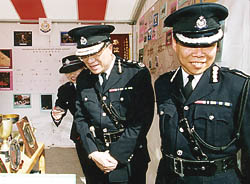 CP Hui and Auxiliary Police Commandant Chau Cham-chiu tour the open day displays SUNDAY 22 November not only saw CP Hui take the salute and review the passing-out parade of auxy constable squads 1 through 5 of 1998, it also marked the occasion of the first ever Hong Kong Auxiliary Police Open Day during which time the new Auxy Police Headquarters in Kowloon Bay was opened to the public who were entertained by the HKAPF Pipe & Drum Band and witnessed "quick response" police demonstrations by Auxiliary Training Section staff. Visitors were also treated to a tour of the new Auxiliary Police Force complex which included its mock court room, firearms training simulator room Ал and specially set up display booths and pictorial exhibits featuring all aspects of auxy and regular police. CP Hui also officially opened the HKAPF library. |
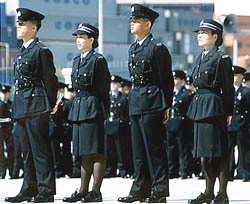 Other winners of the Silver Whistle for best-all-round constable in their passing-out recruit constable squads were: WPCA Anna Lau (1/98), PCA Li Chi-to (2/98), WPCA Wong Yuet-yee (3/98), and PCA Chan Ka-lok (5/98)
|
|
The Hong Kong Auxiliary Police Force, its proud history dating back to 1914 when a volunteer Police Reserve was formed to assist the regular police during World War I, is today still manned entirely by part-time volunteers from all walks of life. The Auxiliary Police Force has its own distinct rank structure, however, its members are fully integrated with their regular counterparts to carry out a wide variety of constabulary duties in the fields of crime prevention, neighbourhood policing, traffic control, special duties and community relations. An average of 583 auxy officers per day are deployed on police duties in support of the regular Force. Currently the Auxiliary Police Force has an establishment of 5,721 officers. | |
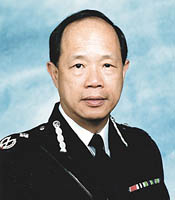 | ON 17 Novenber, the
Government announced the appointment of Senior Assistant Commissioner of Police Benny
Ng Ching-kwok to Commissioner of Correctional Services in March 1999 when the current
Commissioner of CS will be retiring.
Commenting on the appointment, Commissioner of Police Hui Ki-on said that Mr Ng had wide experience in a variety of law enforcement and management positions. Mr Hui said: "I have no doubt that he will rise to the challenge of his new post. He will be a loss to the Hong Kong Police Force. I wish him every success in his new appointment." |
| Mr Ng's replacement will be found by internal promotion and will be announced in due course. | |

